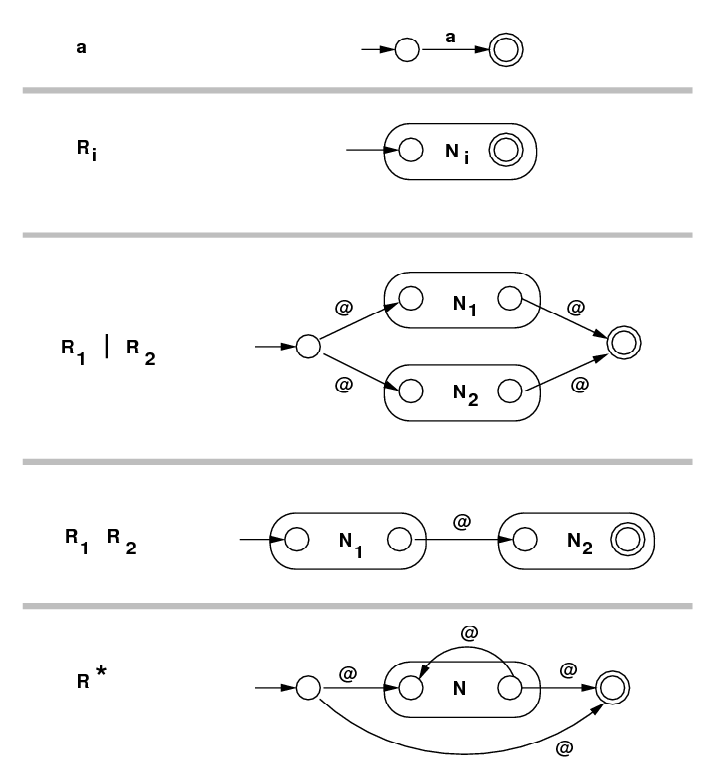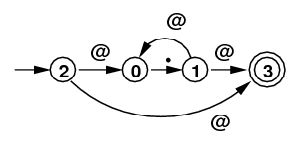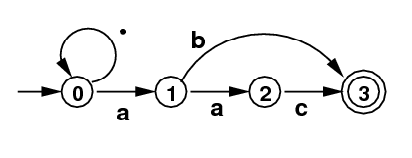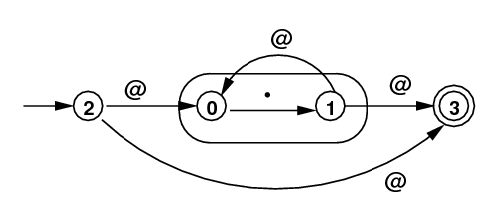 |
CS 3723 Programming Languages |
RE −−> NFA | |
Regular Expression −−> NFA with ε-moves: Given an arbitrary regular expression R, it describes a language, that is, a set of strings of symbols over some alphabet. From R, we want to create an NFA with ε-moves called N so that N accepts any string described by R and rejects any other string. Then we would implement N with a program. The result a regular expression recognizer. First we would use syntax techniques that will be presented later in this course to break R up into a sequence of elementary steps, each one using a single operator. Then we handle the operators one-at-a-time to translate to N. The table below shows how this can be done, with each component regular expression on the left and the corresponding NFA on the right.
| Regular Expression |
NFA with ε-moves Constructed |
|---|---|

| |
Example 1: We'll use a slash at the start and end of our regular expressions. Suppose
-
R = /.*(ab|aac)/
Programming Example 1:
- Regular Expression: /.*(ab|aac)/
- RPN Form or Regular Expression: .*ab+aa+c+|+$
- Input String to Match: cabcaaacabac$
- Corresponding Ruby Program: abaac.rb
| Input Processed |
NFA (so far) |
NFA (graph representation) | Controlling Stack |
|---|---|---|---|
| . |
 |
0 --> [., 1] 1 |
[0, 1](top) |
| .* |
 |
0 --> [., 1] 1 --> [@, 0] --> [@, 3] 2 --> [@, 3] --> [@, 0] 3 |
[2, 3](top) |
| .*ab+ |
 |
4 --> [a, 5] 5 --> [@, 6] 6 --> [b, 7] 7 |
[4, 7](top) [2, 3] |
|
.*ab+aa+c+ (2 steps) |
 |
8 --> [a, 9] 9 --> [@,10] 10 --> [a,11] 11 --> [@,12] 12 --> [c,13] 13 |
[8,13](top) [4, 7] [2, 3] |
|
.*ab+aa+c+|+ (2 steps)  |
0 --> [., 1] 1 --> [@, 0] --> [@, 3] 2 --> [@, 3] --> [@, 0] 3 --> [@,14] 4 --> [a, 5] 5 --> [@, 6] 6 --> [b, 7] 7 --> [@,15] 8 --> [a, 9] 9 --> [@,10] 10 --> [a,11] 11 --> [@,12] 12 --> [c,13] 13 --> [@,15] 14 --> [@, 8] --> [@, 4] 15 --> |
[2,15](top) |
|
Simulating the NFA in Example 1:
| NFA (graph representation) |
Simulation Trace |
|---|---|
Reg. Expr: /.*(ab|aac)/ RPN Form: .*ab+aa+c+|+$ The NFA as a graph: 0 --> [., 1] 1 --> [@, 0] --> [@, 3] 2 --> [@, 3] --> [@, 0] 3 --> [@,14] 4 --> [a, 5] 5 --> [@, 6] 6 --> [b, 7] 7 --> [@,15] 8 --> [a, 9] 9 --> [@,10] 10 --> [a,11] 11 --> [@,12] 12 --> [c,13] 13 --> [@,15] 14 --> [@, 8] --> [@, 4] 15 --> |
Input string to match: cabcaaacabac$ Successive sets of states: | 1 1 1 1 1 1 | 0 1 2 3 4 5 6 7 8 9 0 1 2 3 4 5 | - - - - - - - - - - - - - - - - : 0 0 1 0 0 0 0 0 0 0 0 0 0 0 0 0 s : 1 0 1 1 1 0 0 0 1 0 0 0 0 0 1 0 s c: 1 1 0 1 1 0 0 0 1 0 0 0 0 0 1 0 a: 1 1 0 1 1 1 1 0 1 1 1 0 0 0 1 0 b: 1 1 0 1 1 0 0 1 1 0 0 0 0 0 1 1 t c: 1 1 0 1 1 0 0 0 1 0 0 0 0 0 1 0 a: 1 1 0 1 1 1 1 0 1 1 1 0 0 0 1 0 a: 1 1 0 1 1 1 1 0 1 1 1 1 1 0 1 0 a: 1 1 0 1 1 1 1 0 1 1 1 1 1 0 1 0 c: 1 1 0 1 1 0 0 0 1 0 0 0 0 1 1 1 t a: 1 1 0 1 1 1 1 0 1 1 1 0 0 0 1 0 b: 1 1 0 1 1 0 0 1 1 0 0 0 0 0 1 1 t a: 1 1 0 1 1 1 1 0 1 1 1 0 0 0 1 0 c: 1 1 0 1 1 0 0 0 1 0 0 0 0 0 1 0 |
Example 2:
- Regular Expression: /.*(ab|ac)(ab|ac)*d/
- RPN Form or Regular Expression: .*ab+ac+|+ab+ac+|*+d+$
- Input String to Match: aabacacdccacabddaadcad$
| NFA (graph representation) |
Simulation Trace |
|---|---|
Reg. Expr: /.*(ab|ac)(ab|ac)*d/ RPN Form: .*ab+ac+|+ab+ac+|*+d+$ The NFA as a graph: 0 --> [., 1] 1 --> [@, 0] --> [@, 3] 2 --> [@, 3] --> [@, 0] 3 --> [@,12] 4 --> [a, 5] 5 --> [@, 6] 6 --> [b, 7] 7 --> [@,13] 8 --> [a, 9] 9 --> [@,10] 10 --> [c,11] 11 --> [@,13] 12 --> [@, 8] --> [@, 4] 13 --> [@,24] 14 --> [a,15] 15 --> [@,16] 16 --> [b,17] 17 --> [@,23] 18 --> [a,19] 19 --> [@,20] 20 --> [c,21] 21 --> [@,23] 22 --> [@,18] --> [@,14] 23 --> [@,22] --> [@,25] 24 --> [@,25] --> [@,22] 25 --> [@,26] 26 --> [d,27] 27 --> |
Input string to match: aabacacdccacabddaadcad$ Successive sets of states: | 1 1 1 1 1 1 1 1 1 1 2 2 2 2 2 2 2 2 | 0 1 2 3 4 5 6 7 8 9 0 1 2 3 4 5 6 7 8 9 0 1 2 3 4 5 6 7 | - - - - - - - - - - - - - - - - - - - - - - - - - - - - : 0 0 1 0 0 0 0 0 0 0 0 0 0 0 0 0 0 0 0 0 0 0 0 0 0 0 0 0 s : 1 0 1 1 1 0 0 0 1 0 0 0 1 0 0 0 0 0 0 0 0 0 0 0 0 0 0 0 s a: 1 1 0 1 1 1 1 0 1 1 1 0 1 0 0 0 0 0 0 0 0 0 0 0 0 0 0 0 a: 1 1 0 1 1 1 1 0 1 1 1 0 1 0 0 0 0 0 0 0 0 0 0 0 0 0 0 0 b: 1 1 0 1 1 0 0 1 1 0 0 0 1 1 1 0 0 0 1 0 0 0 1 0 1 1 1 0 a: 1 1 0 1 1 1 1 0 1 1 1 0 1 0 0 1 1 0 0 1 1 0 0 0 0 0 0 0 c: 1 1 0 1 1 0 0 0 1 0 0 1 1 1 1 0 0 0 1 0 0 1 1 1 1 1 1 0 a: 1 1 0 1 1 1 1 0 1 1 1 0 1 0 0 1 1 0 0 1 1 0 0 0 0 0 0 0 c: 1 1 0 1 1 0 0 0 1 0 0 1 1 1 1 0 0 0 1 0 0 1 1 1 1 1 1 0 d: 1 1 0 1 1 0 0 0 1 0 0 0 1 0 0 0 0 0 0 0 0 0 0 0 0 0 0 1 t c: 1 1 0 1 1 0 0 0 1 0 0 0 1 0 0 0 0 0 0 0 0 0 0 0 0 0 0 0 c: 1 1 0 1 1 0 0 0 1 0 0 0 1 0 0 0 0 0 0 0 0 0 0 0 0 0 0 0 a: 1 1 0 1 1 1 1 0 1 1 1 0 1 0 0 0 0 0 0 0 0 0 0 0 0 0 0 0 c: 1 1 0 1 1 0 0 0 1 0 0 1 1 1 1 0 0 0 1 0 0 0 1 0 1 1 1 0 a: 1 1 0 1 1 1 1 0 1 1 1 0 1 0 0 1 1 0 0 1 1 0 0 0 0 0 0 0 b: 1 1 0 1 1 0 0 1 1 0 0 0 1 1 1 0 0 1 1 0 0 0 1 1 1 1 1 0 d: 1 1 0 1 1 0 0 0 1 0 0 0 1 0 0 0 0 0 0 0 0 0 0 0 0 0 0 1 t d: 1 1 0 1 1 0 0 0 1 0 0 0 1 0 0 0 0 0 0 0 0 0 0 0 0 0 0 0 a: 1 1 0 1 1 1 1 0 1 1 1 0 1 0 0 0 0 0 0 0 0 0 0 0 0 0 0 0 a: 1 1 0 1 1 1 1 0 1 1 1 0 1 0 0 0 0 0 0 0 0 0 0 0 0 0 0 0 d: 1 1 0 1 1 0 0 0 1 0 0 0 1 0 0 0 0 0 0 0 0 0 0 0 0 0 0 0 c: 1 1 0 1 1 0 0 0 1 0 0 0 1 0 0 0 0 0 0 0 0 0 0 0 0 0 0 0 a: 1 1 0 1 1 1 1 0 1 1 1 0 1 0 0 0 0 0 0 0 0 0 0 0 0 0 0 0 d: 1 1 0 1 1 0 0 0 1 0 0 0 1 0 0 0 0 0 0 0 0 0 0 0 0 0 0 0 |
Example 3:
- Regular Expression: /.*(ab)*c/
- RPN Form or Regular Expression: .*ab+*+c+$
- Input String to Match: dddabababcdddababcddd$
- Corresponding Ruby Program: ab.rb
| NFA (graph representation) |
Simulation Trace |
|---|---|
Reg. Expr: /.*(ab)*c/ RPN Form: .*ab+*+c+$ The NFA as a graph: 0 --> [., 1] 1 --> [@, 0] --> [@, 3] s 2 --> [@, 3] --> [@, 0] 3 --> [@, 8] 4 --> [a, 5] 5 --> [@, 6] 6 --> [b, 7] 7 --> [@, 4] --> [@, 9] 8 --> [@, 9] --> [@, 4] 9 --> [@,10] 10 --> [c,11] t 11 --> |
Input string to match: dddabababcdddababcddd$ Successive sets of states: | 1 1 | 0 1 2 3 4 5 6 7 8 9 0 1 | - - - - - - - - - - - - : 0 0 1 0 0 0 0 0 0 0 0 0 s : 1 0 1 1 1 0 0 0 1 1 1 0 s d: 1 1 0 1 1 0 0 0 1 1 1 0 d: 1 1 0 1 1 0 0 0 1 1 1 0 d: 1 1 0 1 1 0 0 0 1 1 1 0 a: 1 1 0 1 1 1 1 0 1 1 1 0 b: 1 1 0 1 1 0 0 1 1 1 1 0 a: 1 1 0 1 1 1 1 0 1 1 1 0 b: 1 1 0 1 1 0 0 1 1 1 1 0 a: 1 1 0 1 1 1 1 0 1 1 1 0 b: 1 1 0 1 1 0 0 1 1 1 1 0 c: 1 1 0 1 1 0 0 0 1 1 1 1 t d: 1 1 0 1 1 0 0 0 1 1 1 0 d: 1 1 0 1 1 0 0 0 1 1 1 0 d: 1 1 0 1 1 0 0 0 1 1 1 0 a: 1 1 0 1 1 1 1 0 1 1 1 0 b: 1 1 0 1 1 0 0 1 1 1 1 0 a: 1 1 0 1 1 1 1 0 1 1 1 0 b: 1 1 0 1 1 0 0 1 1 1 1 0 c: 1 1 0 1 1 0 0 0 1 1 1 1 t d: 1 1 0 1 1 0 0 0 1 1 1 0 d: 1 1 0 1 1 0 0 0 1 1 1 0 d: 1 1 0 1 1 0 0 0 1 1 1 0 |
Example 1 Without ε-moves: Here is the final NFA with ε-moves (called N above) written in a simple way as an NFA without ε-moves. It will be a recitation exercise to transform this into a DFA that accepts the same language.

Revision date: 2013-09-07. (Please use ISO 8601, the International Standard.)


